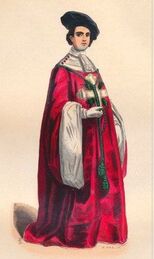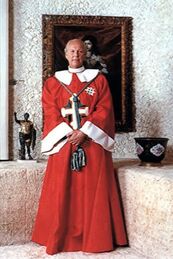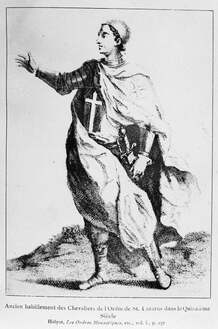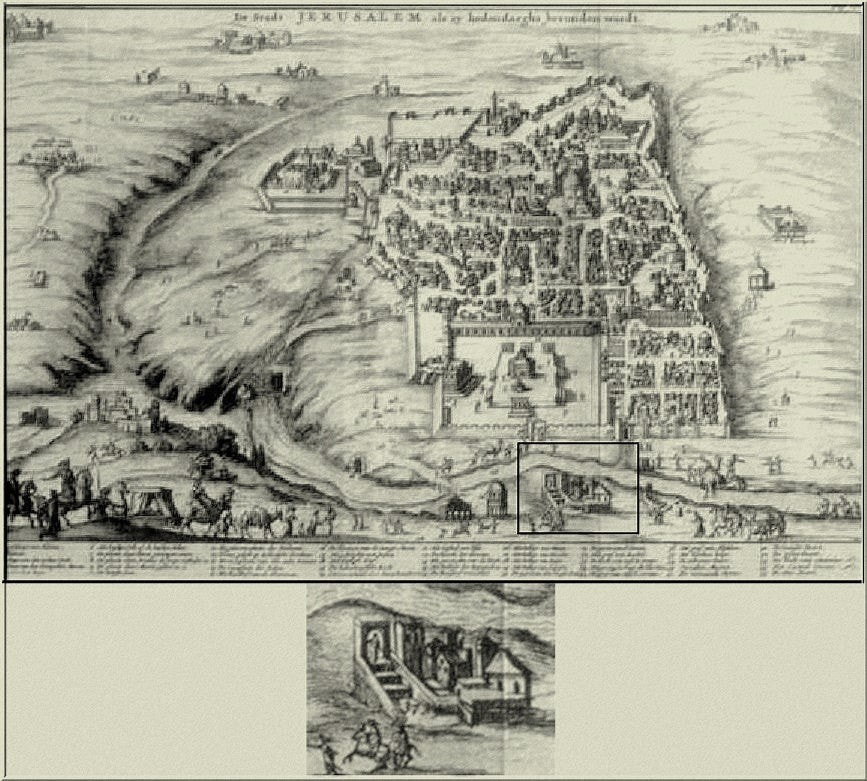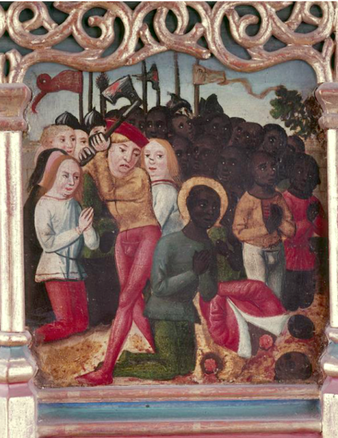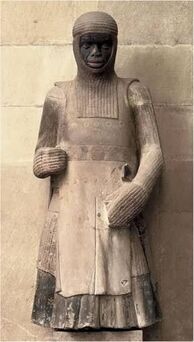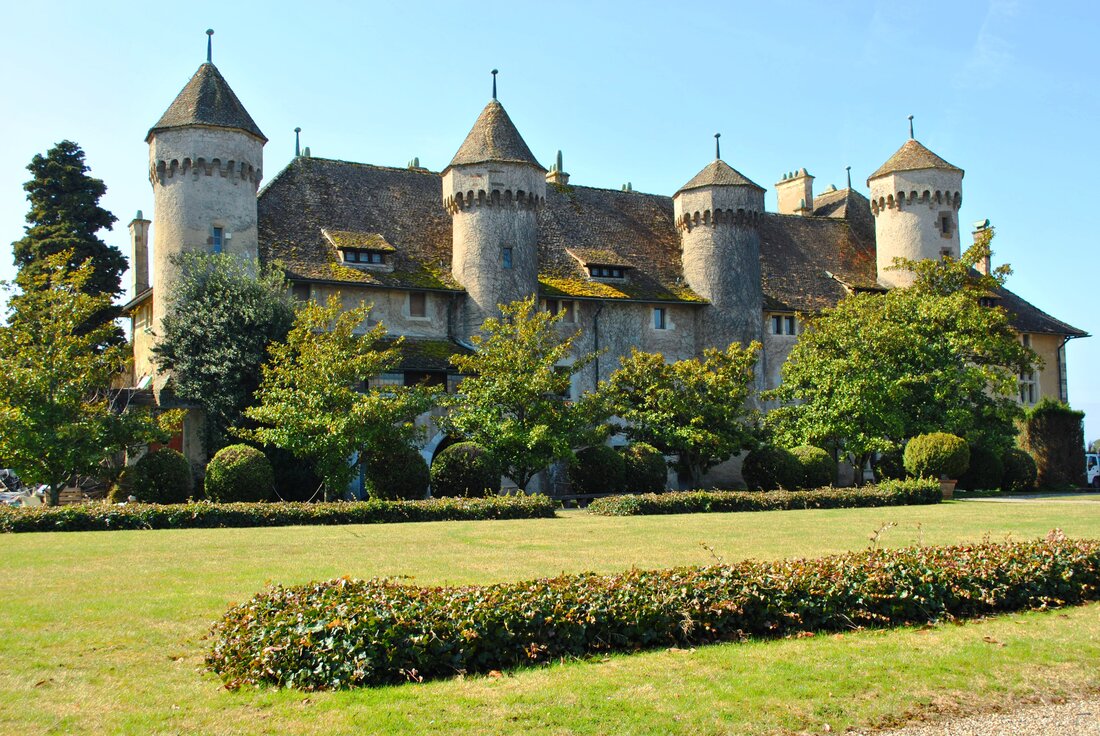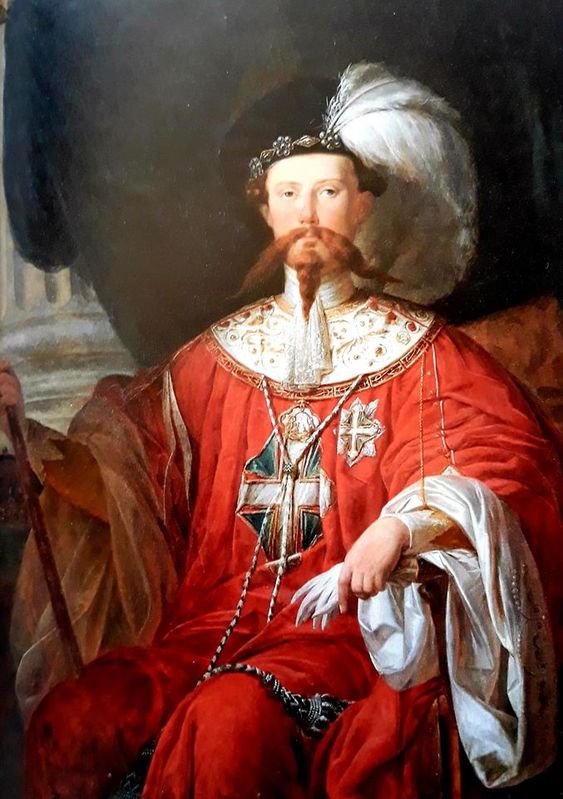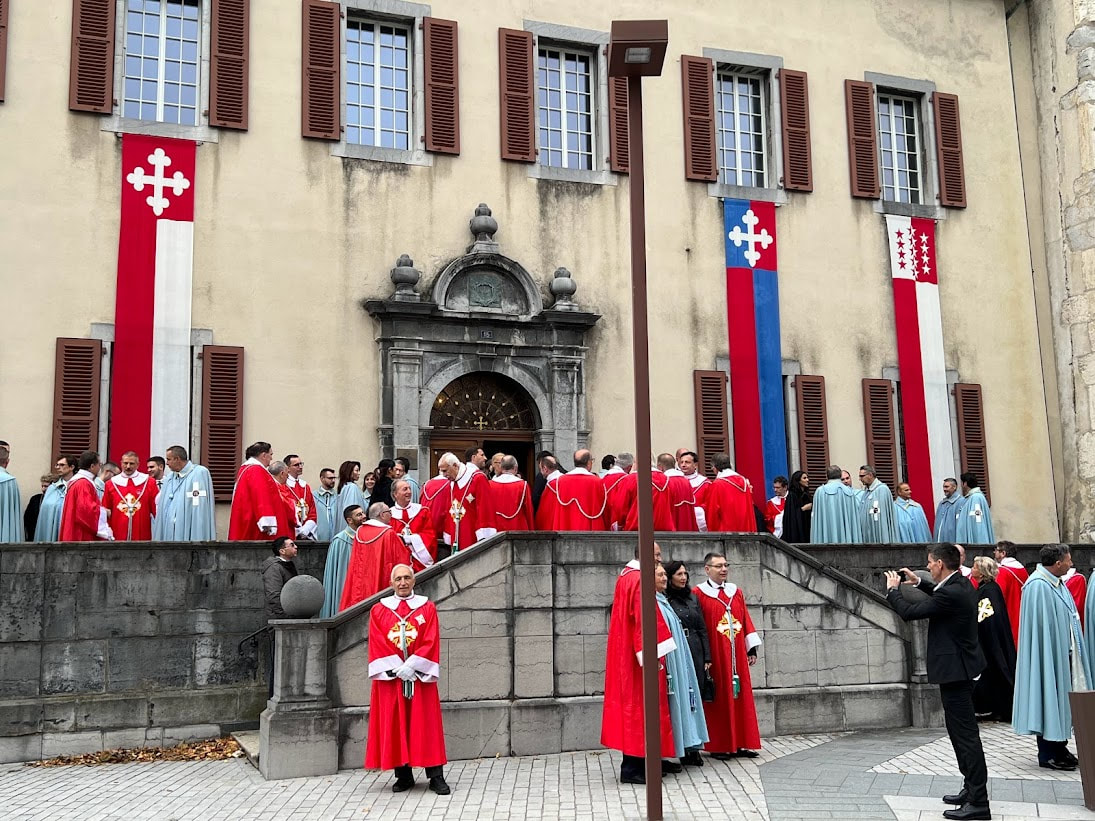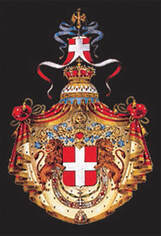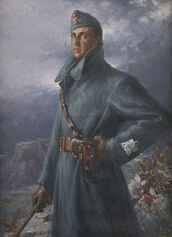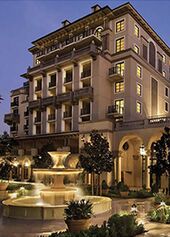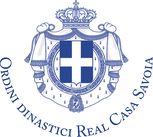American Delegation of Savoy Orders
BRIEF HISTORY
OF THE
ORDER OF SAINTS MAURICE AND LAZARUS
BY
LOUIS MENDOLA
A few knightly orders are particularly distinguished for their venerable antiquity and noble purpose. One of these is the Order of Saints Maurice and Lazarus, a dynastic order of the Royal House of Savoy. Until 1946, it was the highest-ranking award for merit in Italy. Although a unique combination of two aristocratic institutions, joined together in the sixteenth century, it became an Italian distinction resembling the French Legion of Honor and, in more recent years, it has been restored somewhat to its medieval role. Because the institution as it exists today results from the amalgamation of two medieval orders, it is worth considering the origins of each. If regarded from the point of view of its elder branch, the Order of Saint Lazarus, which is rooted in the era of the Crusades, the Order of Saints Maurice and Lazarus may claim a place alongside the oldest extant order of knighthood, the Order of Saint John of Jerusalem (today the Sovereign Military Order of Malta). (1)
The Order of Saint LazarusA hospital for lepers had been established in Palestine sometime before 1100, perhaps around the same time as the Hospital of Saint John (circa 1070), and by 1148, a hospitaller brotherhood had appeared in the Holy Land named after Saint Lazarus, the Patron of Lepers. In these early years, the Order's Grand Master was usually a leper, as were many of the brothers. One of the earliest surviving documents relating to the Order is the approval by King Louis VII of France, a few years later, of a feudal transfer to it. The first Grand Master known to us is a certain Hugues de Saint Paul, circa 1155. In the mid-thirteenth century, the Order of Saint Lazarus was formally recognised as a military and hospitaller order by a Papal Bull which confirmed to it the religious rule of Saint Augustine. As long as the Crusaders were able to maintain themselves in Palestine, the Knights of Saint Lazarus devoted their efforts to aiding the victims of leprosy. Their heraldic symbol was an eight-pointed cross similar to the Cross of Malta but tinctured deep green (vert). It was probably at some time in the thirteenth century that the Order became a military institution, and it seems to have been favored particularly by Pope Clement IV, though there is a curious dearth of historical documentation regarding its early activities. The Knights of Saint Lazarus went back to Europe around 1290, after Islam finally forced the Christians from Palestine and northern Africa. Unlike the Order of Malta, the Knights of Saint Lazarus were not able to found a territorial state of their own, although they established a number of commanderies and hospices in Western Europe, particularly in Sicily, Southern Italy and France, but also in Spain and elsewhere. In 1318 Pope John XXII granted them exemption from local ecclesiastical authority, making the Order dependent on the Holy See. |
The individual members rendered hospitaller service over the next three centuries but, with the exception of a few prominent priories (such as that at Capua), the size and activity Order gradually diminished. It should be noted that, perhaps as early as the fourteenth century, the terms "lazaretto"and "lazar-house" had come to be used generically for any confinement house for patients suffering from communicable disease, and not every institution named for the Saint was, in fact, a hospice of the Order; it is therefore possible that the number of hospices belonging to the Order of Saint Lazarus has been inadvertently exaggerated by historians who presumed that all such institutions to appertain to the Order. (2) Beginning in the latter decades of the fifteenth century, a series of Papal Bulls ceded the remaining patrimony and assets of the Order of Saint Lazarus to the Order of the Hospital. However, certain of the Bulls were not universally respected; this was particularly true in France, where resistance was so widespread that the Crown itself eventually acted against the effect of the Bulls. (3) A Bull of 1517 recognized the Prior of Capua as Grand Master with authority over several monastic hospices, including that of Saint John of the Lepers, the conventual church of which still stands in Palermo. Over the next five decades, various Bulls and Briefs followed. Most of these were an attempt to further partition the assets of the Order in various realms. (4) By 1572, the Order's commanderies in most of Italy found themselves under the leadership of the Milanese nobleman Gianotto Castiglione, who is referred to in some Italian histories of the Order as its "Grand Master." Some histories state that he willed the grand magistry to the Duke of Savoy, others that he negotiated it to him. Whether he had the legal right to do so remains open to debate, for it was not a dynastic order vested in him personally, although Papal diplomacy was certainly involved. The transfer of these commanderies was ratified with the Bull Pro Commissa, issued 13 November 1572, and the grand magistry of the Order of Saint Lazarus was formally conceded to Emanuele Filiberto of Savoy and his perpetual successors, and joined to that dynasty's Order of Saint Maurice. (5) |
The Order of Saint MauriceSaint Maurice has long been regarded as the Patron of the House of Savoy. An early Christian general of Rome's Theban Legion in Alpine Gaul, Mauricius was ordered by Maximian to quell a Christian rebellion circa 286. When he and his military companions refused to murder fellow Christians, they were executed themselves at Agaunum (now Saint Maurice) by Maximian, who later became Roman Emperor. The relics of Saint Maurice are kept at the Abbey of Saint Maurice in the Swiss town named for him, on the River Rhône south-east of Lake Geneva, where the Grand Master and knights of the Order of Saints Maurice and Lazarus attend a ceremonial mass around the martyr's feast, the 22nd of September. Widely venerated in Switzerland, Aosta and Piedmont, Saint Maurice is the patron of mounted knights, infantry and horses. When Amedeo VIII, an aged widower, retired to the Monastery of Ripaglia( Ripaille) near Lake Geneva in 1434, he organised a small group of older noblemen to keep him company. On October 16 of the same year he formed them into a company he called the Knights of Saint Maurice. The new knights constituted a religious brotherhood, though not a monastic order per se. They wore gray robes bearing a white cross in cloth, each arm of which was "trifoliate" at the end. This became the distinctive cross bottony of Saint Maurice and appears on a number of coins issued by the rulers of Savoy. The attempt of Amedeo VIII to spend his last days in quiet contemplation was interrupted by his election to the Papacy as the anti-pope Felix V in 1439, a pontificate he resigned ten years later, recognising Nicholas V as the true Pontiff. The Order he founded, which at first was little more than a noble confraternity, does not seem to have had a particularly active existence after his election as Pope, nor to have survived his death, as a cardinal of the Church, in January 1451. By the middle of the sixteenth century, the Order of Saint Maurice had a very tenuous existence, if indeed it existed at all. (Not a single royal decree pertaining to the Order during this period is known to have survived.) At that time, however, a new spirit began to animate Catholic Europe. For almost a century, the Church had reeled under the blows dealt by the Protestant Reformation. Now she experienced a movement known as the "Counter Reformation." At the same time, the danger always implicit in Islam had become a very pressing one. The coast of Italy and Mediterranean Europe were ravaged by Turkish and Muslim corsairs. |
|
At this juncture Emanuele Filiberto, one of the strongest members of his dynasty, became Duke of Savoy. As an Italian Catholic sovereign and able soldier, he was interested in preventing the spread of the Reformation's political influence within his dominions, though the House of Savoy had always demonstrated a particular tolerance for persecuted, and therefore less influential, religious minorities such as the Waldensians and Jews. In truth, he was far more concerned about the effect on commercial activity caused by the marauding corsairs, but in the interest of combating the spread of Protestant influence in the politically and strategically vulnerable Savoy realm, he revived the Order of Saint Maurice, whose knights were to found hospitals and act as missionaries of the Counter Reformation. The Order also included a special clerical grade.
With the Bull Cristiani Populi of 16 September 1572, Pope Gregory XIII recognised a religious rule for the Order of Saint Maurice. He also recognised, in perpetuity, the succession to the grand magistry through the heads of the House of Savoy. (6) THE ORDER OF SAINTS MAURICE AND LAZARUS The Order Before 1815 Two months later, the Order of Saint Maurice was amalgamated to the Order of Saint Lazarus with the Bull Pro Commissa. (5) Emanuele Filiberto called a chapter general at Nice in 1573, at which he accepted a number of knights of Saint Lazarus into the newly-amalgamated Order. He instituted the first Statutes of the Order of Saints Maurice and Lazarus and founded the Hospital of Saint Maurice in Turin, which would be the first of many. He then set about pursuing his more immediate political goal, that of combating Muslim military and pirate activity in the Mediterranean. According to tradition, he would not have been the first member of his dynasty to do so. A legend was spawned, long after the alleged event took place, that one of Emanuele Filiberto's predecessors had assisted the Order of Saint John at one of the battles of Rhodes. Although the story is not supported by historical facts, it has been advanced to explain the allusive meaning of the Savoy's motto and battle cry FERT, Fortitudo eius Rhodum tenuit, and their use of a coat of arms (gules a cross argent) identical to that of the Order of Malta. (7) The knights of the united fraternity were to give excellent service against the Turks. The Order had two galleys, the "Piemontessa" and the "Margarita," in operation within the year, following the naval example set by the Order of Malta. A closer analogy may be made to the Order of Saint Stephen of Tuscany, a dynastic institution likewise enlisted in the naval wars of the Mediterranean, and viewed by the Papacy in the same light as the Order of Saints Maurice and Lazarus. As the Turks were gradually forced back into Asia Minor during the next century, the purely military activities of the "Ordine Mauriziano," as it is still often called, were replaced by the building and operation of hospitals in strategic parts of Piedmont. This would remain its principal activity for the next few centuries. |
|
The Order Before 1815 Two months later, the Order of Saint Maurice was amalgamated to the Order of Saint Lazarus with the Bull Pro Commissa. (5) Emanuele Filiberto called a chapter general at Nice in 1573, at which he accepted a number of knights of Saint Lazarus into the newly-amalgamated Order. He instituted the first Statutes of the Order of Saints Maurice and Lazarus and founded the Hospital of Saint Maurice in Turin, which would be the first of many. He then set about pursuing his more immediate political goal, that of combating Muslim military and pirate activity in the Mediterranean. According to tradition, he would not have been the first member of his dynasty to do so. A legend was spawned, long after the alleged event took place, that one of Emanuele Filiberto's predecessors had assisted the Order of Saint John at one of the battles of Rhodes. Although the story is not supported by historical facts, it has been advanced to explain the allusive meaning of the Savoy's motto and battle cry FERT, Fortitudo eius Rhodum tenuit, and their use of a coat of arms (gules a cross argent) identical to that of the Order of Malta. (7) The knights of the united fraternity were to give excellent service against the Turks. The Order had two galleys, the "Piemontessa" and the "Margarita," in operation within the year, following the naval example set by the Order of Malta. A closer analogy may be made to the Order of Saint Stephen of Tuscany, a dynastic institution likewise enlisted in the naval wars of the Mediterranean, and viewed by the Papacy in the same light as the Order of Saints Maurice and Lazarus. As the Turks were gradually forced back into Asia Minor during the next century, the purely military activities of the "Ordine Mauriziano," as it is still often called, were replaced by the building and operation of hospitals in strategic parts of Piedmont. This would remain its principal activity for the next few centuries.At first, members were divided into two classes, called "knights of the great cross" (i.e. grand cross) and "knights of the small cross" (i.e. knights). They had to be of noble birth and request admission to the Order. After their petitions had been accepted by the Council, they paid a fixed sum "in passage money" to the Treasury and had to serve five years in the Army or Navy of Saint Maurice. Their lives had a semireligious character. Those who donated a sufficient amount of property to found a commandery (a financially self supporting administrative unit) were called commanders "of Giuspatronato," and their eldest sons could inherit their knighthood in the Order and eventually the commandery, with the income attached to it. In certain respects, the Order remained a state within a state, with its own lands and internal civil administration controlled by dignitaries of the Order and independent of the other Piedmontese of government. In the course of time the Order acquired a considerable amount of property, although its actual independence of Savoy, whose King was Grand Master, naturally declined over the years as its functions became less military and more charitable in nature. The military service requirement was abolished, though in its memory the practice of rendering passage money was not. During this period the full title of the organisation was, properly speaking, "The Sacred Religion and Militia of Saint Maurice and Saint Lazarus." In the meantime, the House of Savoy gained in importance. Vittorio Amedeo became King of Sicily in 1713. Though he spent little time there, preferring Turin to Palermo, he bestowed the Order of Saints Maurice and Lazarus upon a number of Sicilian noblemen. The Sicilian Crown was exchanged for that of Sardinia seven years later, but Turin remained the capital of the Savoyard dominions and the seat of the Order. The stability of the Kingdom and the Order was secure until the French Revolution intervened. Carlo Emanuele IV was forced to retreat to the island of Sardinia in 1796, where he abdicated in favor of his brother, Vittorio Emanuele I, in 1802. The Order, of course, went with him to Sardinia. Its assets, seized by the French, were restored upon the Royal Family's return to Turin. Though the dynasty had survived the war, the times were changing, and with them the Order of Saints Maurice and Lazarus. |
|
|
|
Modernization of the Order Vittorio Emanuele I issued new Statutes on 27 December 1816. These made some concessions to the times. While members continued to be divided into two grades, each grand cross and knight could be either of Justice or of Grace. The former had to be noblemen of ancient lineage. The latter could be admitted for distinguished services, largely of a military or diplomatic nature. Further changes took place on 9 December 1831. Carlo Alberto, one of the most remarkable and democratic monarchs of the nineteenth century, added new grades, such as that of knight grand cross "with Grand Cordon." Strangely enough, the old knights of the grand cross did not automatically become knights grand cross with Grand Cordon; many of them never received the new, higher, dignity. To this day the highest rank of the Order remains "knight grand cross with Grand Cordon," there being no simple "knights grand cross." Clerical grades were abrogated. Regulations establishing a new military uniform for the Order were decreed in 1837. The Medal of Saint Maurice was instituted in 1839 to reward knights of the Order for long military service. The Italian Republic still confers this medal, it being one of the few decorations of the Kingdom's orders of knighthood that was not suppressed in Italy after the fall of the monarchy. (However, it no longer has any affiliation with the Order of Saints Maurice and Lazarus.) As the nineteenth century progressed the Kingdom of Sardinia took a leading role in the ground swell of the "Risorgimento" movement that eventually led to the unification of Italy under one King. These events were reflected within the Order. Carlo Alberto was defeated by the Austrians in 1848 and abdicated in favor of his son Vittorio Emanuele II, later to become King of all Italy. In a regulation dated 16 March 1851, the new Sovereign removed the categories of grace, justice and profession and certain high offices. While the existing ranks remained, the membership within each was now declared to be unlimited. The custom of allowing the Cabinet Ministers to recommend a fixed number of appointments to the Order each year was established in place of prescribing the number of knights in each class. It was in this period that the hereditary commanderies "giuspatronato" were abolished, supplanted by the simple rank of knight commander. All such property reverted to the control of the Council of the Order. On 28 November 1855, a further momentous change took place. The number of grades was increased when Commanders of the First Class were added. A little over two weeks later, on 14 December, the Order was finally divided into five classes like the Legion of Honor. The grade of knight officer was introduced between that of commander, Second Class, and knight. By this date, the Order had clearly assumed the essential character of an order of merit rather than a traditional order of chivalry which existed as a nobiliary body. However, the Order continued to maintain hospitals and schools in Piedmont, and to hold its religious services at basilicas with which it had traditionally been associated. |
|
The Order in the Kingdom of Italy Vittorio Emanuele II became King of Italy in 1861. He founded the Order of the Crown of Italy in 1868 following the annexation of Venice, and in the following year placed control of this new Order with the Council of the Order of Saints Maurice and Lazarus. The last basic change in the ranks took place in 1868. At that time the titles of knight grand officer and knight commander (commendatore) were substituted for commander of the first and second Class. The membership of the first four classes was fixed at sixty for the knights grand cross, one hundred and fifty for the grand officers, five hundred for commanders and two thousand for the officers, with no limit for the number of knights. These figures did not include supernumerary knights, such as knights of the Order of the Annunciation, who had the grand cross by right, or foreigners. Between 1868 and 1907 the only significant regulations affecting the Order were those increasing the membership gradually over the years and limiting the pensions paid some of the knights from the Treasury of the Order. Among the orders bestowed in the Kingdom, the Order of Saints Maurice and Lazarus enjoyed precedence immediately following the Order of the Most Holy Annunciation. Several relevant decrees of this period are worthy of mention. Royal Decree 4851 of 24 January 1869 governs the possible divestiture (attainder) of a knight of the Order of Saints Maurice and Lazarus or the Order of the Crown of Italy, notably for cases of treason and serious felony. Regulations governing the procedures for bestowal of these two orders were issued as magistral decrees on 17 March 1878, and 3 December 1885, amended with Royal Decree 312 of 11 June 1896. By 1900, though its structure and ceremonies bore the mark of a Catholic dynasty, the Order of Saints Maurice and Lazarus was no longer the Roman Catholic institution it had been just a century earlier. On 17 November 1907, King Vittorio Emanuele III signed the Statuto Fondamentale (Fundamental Statutes) of the two orders, reiterating their ranks (i.e. knight, knight officer, knight commander, knight grand officer, knight grand cross decorated with grand cordon) and purpose. With Royal Decree 276 of 16 March 1911, His Majesty modified some rules for bestowal of the dynastic orders. An interesting provision is to be found in Article 4: "No one may be decorated with the Order of Saints Maurice and Lazarus who has not been decorated, for the period of at least one year, in an equal grade of the Order of the Crown of Italy." This practice fell into disuse with the same Sovereign's withdrawal from public life thirty-three years later. Royal Decree 377 of 25 January 1925 established the number of annual bestowals as follows: 6 knights grand cross with grand cordon, 27 knights grand officer, 96 knights commander, 243 officers, 642 knights. Motu proprio bestowals to grand officers, and bestowals to subjects resident abroad, foreigners and certain government officials were supernumerary. |
|
|
The Order After the Monarchy The Italian Republic was founded by Referendum in 1946 and King Umberto II departed for exile, never to return to the land of his birth. He lived until 1983, never having abdicated. The hospitals and other charitable activities supported by the extensive properties and revenues of the old Order are still in operation, though according to the Italian Constitution of 1948 they were assumed by the Italian Republic, which manages them from the building in Rome that formerly housed the Chancery of the Orders of Knighthood. The largest of the hospitals is in Turin. The new state founded its own orders of knighthood, such as the Order of the Star of Italian Solidarity (1947), and retained one of those of the Kingdom of Italy, namely the Order of Merit for Labor. It granted those who received the Order of Saints Maurice and Lazarus before 3 March 1951 the right to wear it in Italy without any restrictions, though knights' rights to places in the order of precedence at public ceremonies were abrogated. However, the same law (Number 178-1951), which founded the Order of Merit of the Italian Republic, sought to "abolish" (or "suppress") the Savoy orders in Italy by outlawing them altogether. The Republic clearly had no right to abolish the incorporeal dynastic patrimony of the exiled King. (8). As King of Italy, Umberto II had the legal right to continue to bestow the orders of the Kingdom of Italy in exile, notwithstanding action by the Italian Republic. He also retained the right to bestow the dynastic orders and, as a lawful fount of honours, to create and recognise titles of nobility. The Italian constitution never stated that titles of nobility were outlawed, but simply that they were "not recognised," although the Consulta Araldica (College of Arms), formerly part of the Interior Ministry, was legally abolished. Following the death of King Umberto, his son and heir, Prince Vittorio Emanuele, acting on the King's testamentary designations, undertook to revitalize the Order to reflect the changes that had taken place in Italy during the last half century. Among other changes, he introduced three ranks for dames in the Statutes of 1985 and reintroduced the rank of hereditary commander "giuspatronato."(9) The Statutes of 1996, though substantively similar to those of 1985, emphasize charitable works, expressing the that the goal of the Order, while recognising merit, should be to concentrate on the charitable purposes for which it was founded in antiquity. To this end, the special office (though not an actual rank) is to be recognized of knights and dames of devotion who donate their time doing actual charitable works in hospitaller institutions. The Order, which is bestowed without respect to nationality or creed, is organised into various national and regional delegations and associations. The Italian Delegations presently include: Abruzzi, Campania and Basilicata, Emilia Romagna, Lazio outside Rome, Liguria, Lombardia, Piedmont and Val d'Aosta, Apulia, Rome, Sardinia, Sicily, Tuscany and Umbria, Triveneto, The Foreign Delegations include: Argentina, Belgium, Hungary, Monaco, Poland, Portugal, Savoy, Spain, Switzerland, the United Kingdom and Ireland, the United States of America. The heraldic insignia of the Order of Saints Maurice and Lazarus is a green cross of eight points vert bearing at each point a roundel or between a cross bottony argent. The decorations are based on this design, with the Cross of Saint Maurice enameled white and that of Saint Lazarus emameled transparent green, suspended from a deep green ribbon. |
Notes
1) The Order of Saints Maurice and Lazarusshould not be confused with the various organizations called the "Order of Saint Lazarus of Jerusalem."
2) See Giacomo Bascape, Gli Ordini Cavallereschi in Italia (Milan 1972), page 36. This book lists excellent bibliographical sources that the interested reader may wish to consult for further information on the topic of this article.
3) This factionalism has fostered the belief that the Order of Saint Lazarus survived someplace in some form long after its grand magistry was ceded to the House of Savoy. The Order of Our Lady of Mount Carmel, founded by King Henry IV of France in 1607, accepted into its ranks the French knights of Saint Lazarus of certain extant French knight commanderies who had chosen not to be affiliated with the Order of Saints Maurice and Lazarus. The Order of Our Lady of Mount Carmel was finally abolished in 1830.
4) In the interest of brevity, the author has mentioned only those Bulls and decrees most important to the history of the Order. However it should be observed that the extensive records retained by the Vatican Secret Archive, the Archive of State of the Province of Turin, and the Archivio Centrale dello Stato (at Rome) are invaluable to serious students of this topic, especially those in search of information concerning particular periods of the Order's history.
5) The heading of Pro Commissa is Bulla Gregorii Papae XIII: Qua Militia Hospitalis Sancti Lazari Hierosolymitani ReligioniSancti Mauritii unitur, ac annectitur.
6) The heading of Cristiani Populi is Bulla Gregorii Papae XIII: Institutionis Militae, ac Religionis Sancti Mauritii in Emanuelem Philibertum Ducem Sabaudiae, successoresques suos, facta collatio.
7) Domenico Guadagnini and others refute the very possibility of the military feat usually attributed to Amedeo V, who died long before the battles of Rhodes. They suggest, however, that the confusion may result from a simple misinterpretation of the historical facts; Amedeo VI was in the Holy Land in 1366 and 1367, when he fought alongside the knights of the Order of Saint John. The coat of arms mentioned had been used much earlier, and appears in certain seals and manuscripts of the thirteenth century.
8) Because the Statuto and certain other documents treat the two orders as the same kind of entity, even placing them in part under the same administration, some legislators argued for the Order of Saints Maurice and Lazarus being a national order rather than a dynastic one. They also advanced the thesis that an independent dynastic institution should not have required that its candidates first belong to a state order (as in Article 4 of the Decree of 1911). However, a close reading of the Statuto makes it clear that, while unitary offices such as the First Secretary were established for convenience, entities such as the Giunta Mauriziana were retained, thus guaranteeing the preservation of the two orders as separate institutions.
9) These testamentary designations included, among other things, the dynasty's donation of the Shroud of Turin to the Holy See.
Bibliography and Acknowledgements
While a few details may appear here for the first time in the English language (notably the information concerning the Order of the Crown in Article 4 of the decree of 1911), very little contained in this article is truly original. Most of this information has been drawn from published Italian sources. For their objectivity and modern point of view, the author is indebted to Domenico Guadagnini's Storia degli Ordini Equestri (Venice 1925) and Giacomo Bascape's Gli Ordini Cavallereschi in Italia (Milan 1972). Among the better known seventeenth, eighteenth and nineteenth century works consulted were those by Taroni, Ricci, Cibrario, Strappezzi, Rossetti and Tioli. Also consulted were several decrees and letters of bestowal from the eighteenth century. For his assistance, the author expresses his gratitude to Professor James Risk, Delegate Emeritus of the American Delegation of the Order of Saints Maurice and Lazarus. Special thanks also to Commendatore Giovanni Angiolini, former member of the Chamber of Deputies, for his information on the legal aspects of the Italian legislation pertaining to the Order of Saints Maurice and Lazarus. He also wishes to express his gratitude to the patient staffs of the Archivio Centrale dello Stato at Rome-EUR and the Vatican Secret Archive. The kind staff of the Archivio di Stato of the Province of Turin is to be commended for their special effort in tracking down works which were not to be found in the places indicated by the catalogues and indices.
(c)1997 L. Mendola
1) The Order of Saints Maurice and Lazarusshould not be confused with the various organizations called the "Order of Saint Lazarus of Jerusalem."
2) See Giacomo Bascape, Gli Ordini Cavallereschi in Italia (Milan 1972), page 36. This book lists excellent bibliographical sources that the interested reader may wish to consult for further information on the topic of this article.
3) This factionalism has fostered the belief that the Order of Saint Lazarus survived someplace in some form long after its grand magistry was ceded to the House of Savoy. The Order of Our Lady of Mount Carmel, founded by King Henry IV of France in 1607, accepted into its ranks the French knights of Saint Lazarus of certain extant French knight commanderies who had chosen not to be affiliated with the Order of Saints Maurice and Lazarus. The Order of Our Lady of Mount Carmel was finally abolished in 1830.
4) In the interest of brevity, the author has mentioned only those Bulls and decrees most important to the history of the Order. However it should be observed that the extensive records retained by the Vatican Secret Archive, the Archive of State of the Province of Turin, and the Archivio Centrale dello Stato (at Rome) are invaluable to serious students of this topic, especially those in search of information concerning particular periods of the Order's history.
5) The heading of Pro Commissa is Bulla Gregorii Papae XIII: Qua Militia Hospitalis Sancti Lazari Hierosolymitani ReligioniSancti Mauritii unitur, ac annectitur.
6) The heading of Cristiani Populi is Bulla Gregorii Papae XIII: Institutionis Militae, ac Religionis Sancti Mauritii in Emanuelem Philibertum Ducem Sabaudiae, successoresques suos, facta collatio.
7) Domenico Guadagnini and others refute the very possibility of the military feat usually attributed to Amedeo V, who died long before the battles of Rhodes. They suggest, however, that the confusion may result from a simple misinterpretation of the historical facts; Amedeo VI was in the Holy Land in 1366 and 1367, when he fought alongside the knights of the Order of Saint John. The coat of arms mentioned had been used much earlier, and appears in certain seals and manuscripts of the thirteenth century.
8) Because the Statuto and certain other documents treat the two orders as the same kind of entity, even placing them in part under the same administration, some legislators argued for the Order of Saints Maurice and Lazarus being a national order rather than a dynastic one. They also advanced the thesis that an independent dynastic institution should not have required that its candidates first belong to a state order (as in Article 4 of the Decree of 1911). However, a close reading of the Statuto makes it clear that, while unitary offices such as the First Secretary were established for convenience, entities such as the Giunta Mauriziana were retained, thus guaranteeing the preservation of the two orders as separate institutions.
9) These testamentary designations included, among other things, the dynasty's donation of the Shroud of Turin to the Holy See.
Bibliography and Acknowledgements
While a few details may appear here for the first time in the English language (notably the information concerning the Order of the Crown in Article 4 of the decree of 1911), very little contained in this article is truly original. Most of this information has been drawn from published Italian sources. For their objectivity and modern point of view, the author is indebted to Domenico Guadagnini's Storia degli Ordini Equestri (Venice 1925) and Giacomo Bascape's Gli Ordini Cavallereschi in Italia (Milan 1972). Among the better known seventeenth, eighteenth and nineteenth century works consulted were those by Taroni, Ricci, Cibrario, Strappezzi, Rossetti and Tioli. Also consulted were several decrees and letters of bestowal from the eighteenth century. For his assistance, the author expresses his gratitude to Professor James Risk, Delegate Emeritus of the American Delegation of the Order of Saints Maurice and Lazarus. Special thanks also to Commendatore Giovanni Angiolini, former member of the Chamber of Deputies, for his information on the legal aspects of the Italian legislation pertaining to the Order of Saints Maurice and Lazarus. He also wishes to express his gratitude to the patient staffs of the Archivio Centrale dello Stato at Rome-EUR and the Vatican Secret Archive. The kind staff of the Archivio di Stato of the Province of Turin is to be commended for their special effort in tracking down works which were not to be found in the places indicated by the catalogues and indices.
(c)1997 L. Mendola
Royal House |
History |
Orders |
Members |
News & Events |





